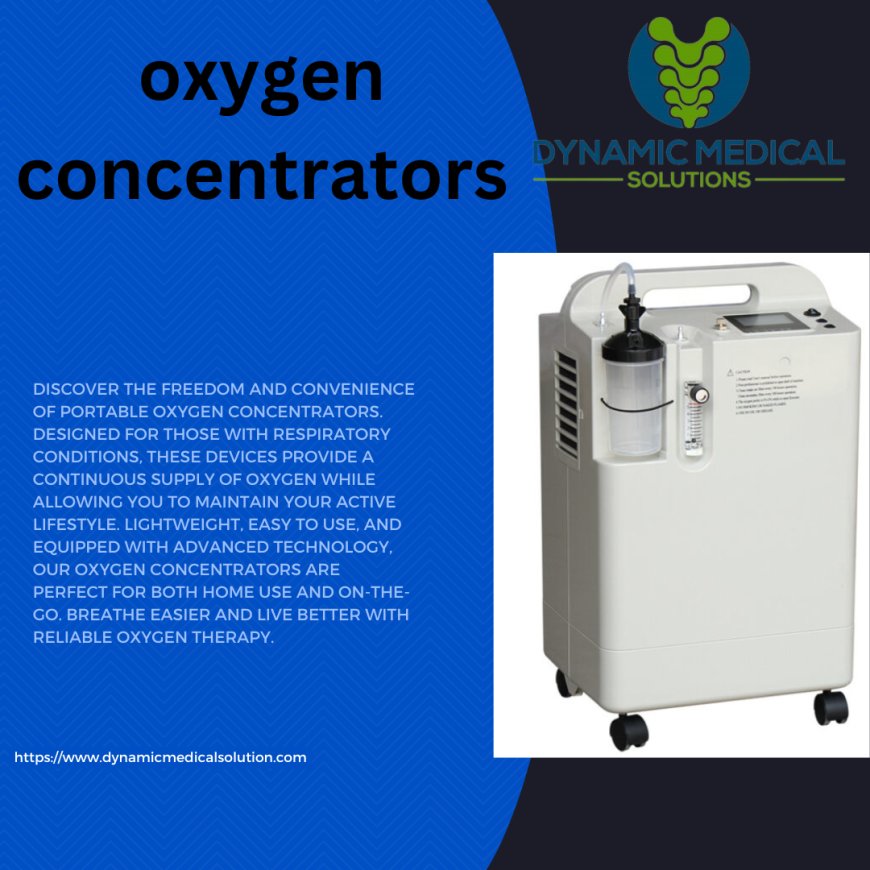The Uses of Oxygen Concentrators
Oxygen concentrators have emerged as crucial medical devices that provide supplemental oxygen to individuals suffering from respiratory conditions

Oxygen concentrators have emerged as crucial medical devices that provide supplemental oxygen to individuals suffering from respiratory conditions. By extracting oxygen from the surrounding air and delivering it to patients in a concentrated form, these devices play a significant role in enhancing health and well-being. Among the various types of oxygen concentrators, the portable oxygen concentrator (POC) has gained particular importance due to its versatility and mobility. This article explores the various uses of oxygen concentrators, highlighting how they benefit individuals in different contexts.
1. Medical Treatment for Respiratory Conditions
The primary use of oxygen concentrators is to provide therapeutic oxygen for individuals with chronic respiratory illnesses. Conditions such as Chronic Obstructive Pulmonary Disease (COPD), asthma, pulmonary fibrosis, and cystic fibrosis can lead to decreased oxygen levels in the blood. Oxygen concentrators are prescribed to help manage these conditions by:
-
Maintaining Oxygen Saturation: By delivering supplemental oxygen, oxygen concentrators help maintain adequate blood oxygen saturation levels, reducing symptoms like shortness of breath and fatigue.
-
Improving Quality of Life: Many patients experience improved overall well-being when using oxygen concentrators, as they can engage more fully in daily activities and social interactions without feeling constrained by their condition.
2. Long-Term Oxygen Therapy (LTOT)
For many patients with chronic respiratory diseases, oxygen concentrators are essential for long-term oxygen therapy. LTOT is a prescribed treatment that enables patients to receive oxygen for extended periods, typically at home. Key benefits include:
-
Continuous Supply: Unlike traditional oxygen tanks, which require frequent refilling, oxygen concentrators provide a continuous flow of oxygen, ensuring patients do not run out unexpectedly.
-
Convenience and Safety: With built-in safety features, oxygen concentrators eliminate the risks associated with high-pressure gas tanks, providing a safer alternative for home use.
3. Portable Oxygen Concentrators for Mobility
The advent of portable oxygen concentrators has transformed how patients manage their oxygen therapy. These compact, lightweight devices are designed for ease of use and mobility, making them ideal for various situations:
3.1. Daily Activities
Portable oxygen concentrators allow users to carry their oxygen therapy with them throughout their daily routines. Whether grocery shopping, attending social events, or engaging in hobbies, patients can maintain their independence and quality of life while receiving necessary oxygen support.
3.2. Travel
Traveling with supplemental oxygen can be challenging, but portable oxygen concentrators have made it more manageable. Many models are FAA-approved for air travel, allowing users to take their devices on flights without hassle. Additionally, POCs can be charged via car chargers, making them suitable for road trips. This flexibility ensures that individuals can maintain their oxygen therapy while enjoying travel and leisure activities.
3.3. Outdoor Activities
For those who enjoy outdoor activities, such as hiking or picnicking, portable oxygen concentrators enable users to participate without feeling restricted. With battery-operated options available, individuals can enjoy fresh air and nature while ensuring they have access to supplemental oxygen when needed.
4. Emergency Situations
Oxygen concentrators can also play a vital role in emergency situations. In cases where individuals experience sudden respiratory distress or exacerbation of their symptoms, having an oxygen concentrator on hand can provide immediate relief. These devices can stabilize patients until they receive further medical assistance, making them valuable in both home settings and healthcare facilities.
5. Rehabilitation and Physical Therapy
For patients recovering from respiratory illnesses or surgeries, oxygen concentrators facilitate rehabilitation and physical therapy. Supplemental oxygen can help:
-
Enhance Exercise Tolerance: During physical therapy sessions, oxygen therapy can improve patients' ability to engage in exercise, promoting recovery and strengthening respiratory muscles.
-
Reduce Fatigue: By ensuring adequate oxygen levels during rehabilitation, patients can experience less fatigue and discomfort, leading to a more effective recovery process.
6. Support for Sleep Apnea
Some individuals with sleep apnea may benefit from the use of oxygen concentrators during sleep. By providing a continuous flow of oxygen, these devices can help maintain proper oxygen saturation levels during the night, improving sleep quality and overall health.
7. Home Healthcare
As the trend towards home healthcare continues to grow, oxygen concentrators are increasingly being utilized in home settings. These devices allow patients to receive necessary oxygen therapy in the comfort of their homes, leading to enhanced convenience and improved health outcomes.
Conclusion
The uses of oxygen concentrators extend far beyond simple oxygen delivery. These devices play a critical role in managing respiratory conditions, enhancing the quality of life for individuals with chronic illnesses, and promoting independence through the use of portable oxygen concentrators.
As technology continues to advance, the capabilities of oxygen concentrators are likely to expand further, making them an even more integral part of respiratory care. Whether for daily activities, travel, emergency situations, or rehabilitation, oxygen concentrators are essential tools that empower individuals to breathe easier and live life to the fullest.
What's Your Reaction?




















